by SIEGFRIED BING
They alone can pretend to fathom the depth of feeling and beauty in an alien art who resolutely determine to scrutinize it from the point of view of an inhabitant of the place of its birth.
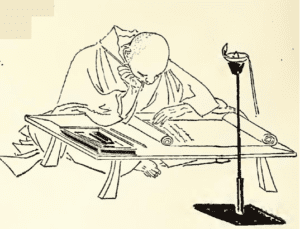
This is a primary condition. If submission to it be refused, if it be intended to refer all manifestations of art, whatever they may be, to a common measure —that which the centuries have fashioned specially for the use of western culture—it were better to omit entirely the study of what has been created away from ourselves. It is of but little use to look at an image if one fails to grasp its sense. Commentaries upon an art should be the outcome of the civilisation of which that art is the crowning outcome and the chief result. The causes of this civilisation, the geographical position of the country, its history, and the temperament of its inhabitants must not be lost sight of. One must follow the development of the country’s manners and make oneself familiar with its institutions.
These are the principles which I would apply here to the study of Japanese Art. Unfortunately so extensive a programme is too large for the frame I have at my disposal. At the best I can but draw an incomplete, and therefore an unfaithful picture of a subject worthy of better things. I shall endeavour, however, to simply define the influence exercised on artistic development by the principal historical and social evolutions.
Just a word to commence with, about the situation and formation of the country. Its elongated shape, something like that of a narrow crescent severed from the Asiatic continent ; its soil torn by numberless arms of the sea, both large and small ; its coasts destroyed by the everlasting wear of the ocean—all has been favourable in the land of the rising sun to the development of an original culture distinct for ages from the strain of European contact, and obliging the inhabitants to search among themselves for the principal conditions of existence, physical as well as intellectual. But these inhabitants —whence have they come, if, as everything seems to prove, their cradle was beneath other skies ? Leaving, perchance, some distant land in Eastern Asia, they reached in legendary time some outlandish point of the picturesque archipelago, driving back from the south to the north the aboriginal half-savage inhabitants, a few descendants of whom still survive in the island of Yesso.
What part of the globe saw the birth of this privileged race, which held within itself the germ of a nature vibrating with life, fit for all refinements, and the noblest and most artistic sensibility? What magician could at one wave of his wand dissipate the darkness of century upon century, to reveal to us the evolution which has made of a race of nomads the people of refinement parexcellence, the genial people, reflecting in a multitude of eloquent creations the emotion evoked in them by the smiling aspect of the country of their adoption. Most certainly such transformations are not the work of a day. The generous sap coursing beneath a rough bark would not have driven forth branches without first becoming strong and healthy after transplantation to a fresh soil. It was necessary before all else that they should be permanently established, in order that they could proceed to a political and social organisation. This labour of the very beginning we cannot follow—no history of it remains to us.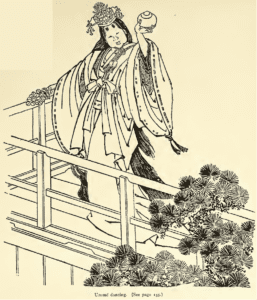
But I make a mistake. The history has been written, but by means of the fabulous forms of epic poems, reminders to us of our own antiquity.
The land of that period was composed as nearly as possible of the eight principal islands of Nippon, which Isanaghi the creative spirit caused to appear, by plunging from the summit of Olympus eight times into the sea his ruby pointed lance. Filled by delight as he roamed over the domain which he had given himself, he desired further to make it fruitful, and his companion Isanami, then gave birth to a large number of spirit beings, and finally she brought into the world the wondrous Amatérasu, goddess of the sun, and Tsuku, the charming deity of the moon, her favourite daughters, to whom were deputed the government of earth and heaven, alternately by day and night. It is from Amatérasu that all those future sovereigns were to descend, who during the first seven generations of a thousand years each will relinquish a part of their divine essence in order to devote themselves to the exclusive ruling of the earth.

The Japanese bible, the kojiki, describes minutely all the points of this period of infancy. We meet there a mythology perhaps not more complicated than our own, but which appears more diffuse and far stranger, for the reason that we have not been brought up with it. In the same way as in Art, one often unwittingly condemns a formula, for the only reason that it is strange to our education.
The Japanese Olympus presents the spectacle of a thousand heroic actions, confused with the most common passions and all the smallnesses of humanity, which the simple belief of people attributes to its gods, making them in its own image.
The legends have furnished to Art a fruitful source for picturesque and sometimes humorous composition.
Here is one of the most popular episodes: —The goddess of the sun, the lovely Amatérasu, exasperated by the turbulence and disordered life of one of her brothers, makes up her mind to be sulky, and takes refuge within a cave. Thus was the universe hidden in darkness, causing dire consternation to all the gods. High counsel was held as to finding a means for enticing from her hiding-place the dispenser of light, supplications, promises, nothing has any effect. Then great concerts are organised around the cavern, and musical instruments bring forth charming melodies and seductive notes, poetical songs resound again, echoed by full-toned cadences. All in vain, the goddess remains 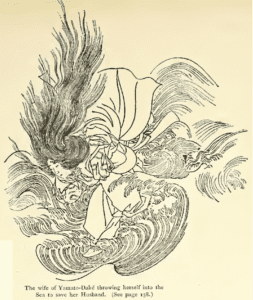 unmoved by the appeals of pleasure, in like manner as she resisted plaintive wailing. Suddenly there steps forward young Uzumé, celebrated for the perfection and spirit of her dancing and singing. She flings herself, with ever- increasing delight, into a wild and fascinating dance, all the gods grouping themselves around her. The dance becomes general, whilst with her notes are mingled the sounds of loud laughter which echoes again in the air. Then they chant a carol in honour of Uzumé — “ Glory, glory is hers, who surpasses in beauty and grace the haughty goddess, who but lately ruled the universe with her surpassing comeliness.” Amatérasu, failing to understand how the general affliction could cause such reckless gaiety—above all, being unable to endure the thought of a triumphant rival—leans her head out of an aperture in the cavern, while at the same time a powerful god, seeing it at this instant, rolls away a portion of the rock, and daylight returns.
unmoved by the appeals of pleasure, in like manner as she resisted plaintive wailing. Suddenly there steps forward young Uzumé, celebrated for the perfection and spirit of her dancing and singing. She flings herself, with ever- increasing delight, into a wild and fascinating dance, all the gods grouping themselves around her. The dance becomes general, whilst with her notes are mingled the sounds of loud laughter which echoes again in the air. Then they chant a carol in honour of Uzumé — “ Glory, glory is hers, who surpasses in beauty and grace the haughty goddess, who but lately ruled the universe with her surpassing comeliness.” Amatérasu, failing to understand how the general affliction could cause such reckless gaiety—above all, being unable to endure the thought of a triumphant rival—leans her head out of an aperture in the cavern, while at the same time a powerful god, seeing it at this instant, rolls away a portion of the rock, and daylight returns.
This goddess of the sun, weary of ruling by herself on the earth, resolved to endue younger spirits with her power. With this intent, she sent from heaven her grandson, Ninighi, whose tomb is still shown at Sendai, in the province of Satsuma. It was a descendent of this demigod who became the first of the Mikados in 585 before our era, the year which saw the commencement of Japanese chronology. It was then that for the last time Amatérasu makes her appearance in person, and sending to the youthful emperor a sword and a metal mirror says—“Preserve this mirror, image of my glory, and your empire shall last while heaven and earth remain.”
It is a fact that since then, during the course of twenty-five centuries, the imperial sceptre has never passed to any other dynasty : the only example in the world’s history. Even to this day the emperor claims descent from his ancestor, the goddess Amatérasu. So it appeared in a proclamation published hardly twenty years ago. One sees also that the Japanese flag has for its emblem a red sun on a white ground, and the imperial armorial bearings, the chrysanthemum, is itself the symbol of a radiant star.
The mirror of Amatérasu was placed in a temple built in the province of Issé in honour of the goddess, a sanctuary most highly venerated, the point of destination for pilgrimages, which still draw thousands and thousands of the faithful.
Thus it was that the Shintoist religion was formed, based on the worship of ancestry and the kamis, genii, and forefathers of the royal house. The Shintoist cult has remained the official religion of Japan.
If I have expatiated at some length on the Japanese theogony, it is not only because it has furnished by its numerous and picturesque events, ample material for artists, but also for the reason that it seems to characterise faithfully the romantic and poetical temperament which have distinguished this people from its very origin. The kojiki, which first enumerates
The events of the fabulous era, was written in the year 711 of our era. We find there the proof of a refined and subtle spirit, which has manifested itself from the earliest time, even before civilisation could have the least root.
The founders of the Imperial dynasty received the posthumous name of Jimmu-Tenno — Tenno means “ King of Heaven ; ” a title which all his successors have take before that of Mikado.
The first portion of the name “Jimmu” means “great genius of war.” It is certain that war or rather conquest impressed itself on Jimmu as a necessity, for it was important that he should give his domain the extent and consideration necessary to constitute a viable state. But it does not in the least follow that he could have no other interest than fighting. At the same time that his power grew greater he showed an enlightened mind, assuring peace in all countries under his rule, and interesting himself in the well-being of his people.  The same has characterised the rule of his successors, who have watched carefully over the independence and security of the empire, whilst bearing in mind the manly spirit of their subjects.
The same has characterised the rule of his successors, who have watched carefully over the independence and security of the empire, whilst bearing in mind the manly spirit of their subjects.
The present emperor will in no way jeopardise his country. Let us congratulate ourselves on this, because it is he who permitted passage to the first current of civilised ideas, which came from outside.
In the year 200 of our era, the fourteenth Mikado determined on a campaign against Corea, but shortly after his departure from Nara, his capital, he died suddenly. His wife, Jingu-Kogo, who accompanied him in this expedition, ordained that the death of the emperor should be kept a secret ; and confiding to an old and tried warrior the charge of her child, but lately born in camp, she donned her husband’s armour, and resolutely put herself at the head of the army. She organised a powerful fleet and landed on the coasts of the enemy. The chiefs of the various kingdoms which constituted the Corean peninsula, seized with terror, submitted themselves to her, and signed a treaty which assured close relations between the two countries—relations which were to have for Japan a weight almost incalculable as regards its intellectual development. These consequences came less, however, from the Corean civilisation itself (the condition of which has never yet been definitely discovered), than from the rôle which, during some centuries, this advanced portion of the continent was to assume as an intermediary between the archipelago of the east and the great Chinese Empire —at that time in full possession of a flourishing culture.
Before examining the sequel to these events, I may be permitted to draw particular attention to the heroic character which history and legend attribute on occasions to Japanese women. The scene where the empress Jingu entrusts her new-born infant to the rough and long-bearded old man, who receives it in his arms with the tender care of a nurse —this touching picture has become a motive for every painter. Another episode, doing honour to feminine virtue, has often inspired the artistic brush : this occurred also during the course of a warlike expedition, undertaken this time by the son of the twelfth Mikado, Yamato-Daké the popular hero, celebrated in a hundred tales. In crossing the Gulf of Yeddo, he had to fight against so furious a sea, that he despaired of reaching the opposite shore ; when his lady love, beautiful and noble beyond all other women, and desiring above all things to save the life of the prince, cast herself into the waves to appease the anger of the lord of the ocean (Compira). Yamato-Daké gave expression to his sorrow in a poem celebrated to this day, in which he names the newly-conquered region as Adzuma–Kuni—“the land of his well-beloved.” The town of Yeddo which was built at the end of the bay, after a great number of centuries, inherited the poetical name of Adzuma in memory of this romantic legend. It was not immediately that the invasion of the Empress Jingu bore fruit. There was first a period of moral laxity in manners which deadened courage, and permitted Corea to free herself to some extent from Japanese supremacy. Towards the middle of the sixth century, and after some new expeditions, the bonds were renewed, and hence ensued an era infinitely fertile for art and letters.
New life galvanised a brain thenceforth ready to welcome the torrent of reformative ideas which were to arrive from Corea. The opening was made to allow for the advent of new moral doctrines for instruction of all kinds, the outcome of a secular civilisation. 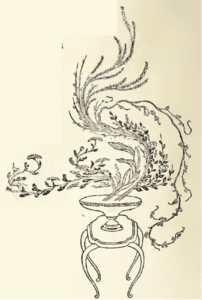 China passed on its secrets of political organisation, disclosed undreamt-of information in therapeutics, the priceless knowledge of its written characters, and of its ancient literature—it communicated, in fact, the example of its arts and its industries.
China passed on its secrets of political organisation, disclosed undreamt-of information in therapeutics, the priceless knowledge of its written characters, and of its ancient literature—it communicated, in fact, the example of its arts and its industries.
Those who make out the apostles of all the religions of the world to be opponents to the onward march of science and the murderers of all progress, will find here no argument in favour of their doctrines. It is the vast propaganda of Buddhist doctrines which has become in Japan the instrument for orientalising science and ideal speculation.
The emperor, at that time a fervent disciple of the national religion of the Kamis, was at first but moderately pleased on seeing the arrival of a crowd of bonzes bringing with them numerous cargoes of buddhist statues, books of prayers and temple ornaments. He demanded of his vassal the King of Koudara, in Corea, to replace this company of holy personages by men of science, philosophers, architects, astrologers, doctors, and artists. But it was not long before he perceived that those who brought the word of a new god were at the same time apostles of science and art. The name of the principals among them have transmitted themselves from generation to generation as benefactors to humanity. These men journeyed from town to town preaching everywhere and endeavouring with no less ardour to raise the intellectual level of the population. They constructed canals and bridges, made embankments, established potteries, kilns, and looms for weaving. They taught calligraphy, which in the extreme East constitutes the primordial form of drawing, for it emanates from the same technical execution, and aims at the same decorative effects.* They demonstrated also the great art of painting for the glorification of the saints of their religion.
* The brush is the only instrument employed in writing as it is in painting, the pencil or the pen being unknown.
The Japanese race is certainly too well endowed to let one suppose that without exterior impetus she would have remained inert. We have too high an opinion of her to judge her incapable of creating an art entirely original to herself. Her annals tell us at any rate of certain national painters who flourished before the end of the fifth century. But if it is beyond doubt that the soil was admirably prepared for the seed, it is not less certain that the first productions of a distinct value date from the epoch which followed the appearance of Buddhism in Japan. Some highly valuable of Chinese painting had been procured and following the example of the new religion itself, the art which it inspired propagated itself rapidly, even amongst the highest circles of society. One finds among the celebrated painters of the date the son of an emperor, renowned also as a poet and a musician, and the most ancient portrait which is preserved to the present day represents a personage of very high position in the state, and a fervent propagator of Buddhistic doctrines. This picture dates from the seventh century and is to be seen in the temple at Nara. It is to be understood (let us remark, in passing) that when speaking of a picture, this word must not be taken in its absolutely literal sense ; all the paintings of the most distant parts of Asia are executed, as is well known, on rolls of silk or paper, which are known in the Japanese language as Kakémono (that is to say, a thing to hang up) when the subject is upright, and under the word Makimono when it stretches itself out in a horizontal manner.
The earliest school of painting in Japan is therefore the BuddhisticSchool. It planted itself under the standard borrowed from the land of its origin, from the holy India which was the cradle of the religion founded by Sakya Muni more than 2500 years ago. Preserving in its style a changelessness which may be compared only to that of the dogma itself and its forms of ritual, this art had followed in its march the great religious extension from the west to the east, passing from country to country as far as the great watery barrier formed by the China Sea and the Pacific Ocean
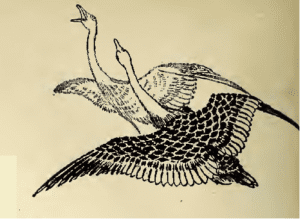 Thus it follows that in its migrations, the faith had lost none of its original intensity, in that it could yet inspire so powerfully the brush of the artist. Without showing such sublime nobility as certain similar works in China, Buddhistic painting in Japan has qualities which remain untangible to profane art. In it we have examples (perhaps unique) of a representation of the Divine Being which are utterly exempt from all passion, and regardless of human sorrows. Everything in the character of these figures tells of an existence which raises itself above the unhappiness of our own world. It evolves from it the sensation of an endless repose and an entire and beatified serenity. The technical execution manifests the deep sentiment which inspired the composition. It is earnest to the utmost degree, and, as it were, full of respect to the subject. Having accomplished simplicity and grandeur in the features, it allows itself full play on the accessories, and the vestments, in fanciful profusion, equal in splendour the marvellous ancient miniatures of India and Persia.
Thus it follows that in its migrations, the faith had lost none of its original intensity, in that it could yet inspire so powerfully the brush of the artist. Without showing such sublime nobility as certain similar works in China, Buddhistic painting in Japan has qualities which remain untangible to profane art. In it we have examples (perhaps unique) of a representation of the Divine Being which are utterly exempt from all passion, and regardless of human sorrows. Everything in the character of these figures tells of an existence which raises itself above the unhappiness of our own world. It evolves from it the sensation of an endless repose and an entire and beatified serenity. The technical execution manifests the deep sentiment which inspired the composition. It is earnest to the utmost degree, and, as it were, full of respect to the subject. Having accomplished simplicity and grandeur in the features, it allows itself full play on the accessories, and the vestments, in fanciful profusion, equal in splendour the marvellous ancient miniatures of India and Persia.
Unfortunately it is impossible to do justice in the reproductions of authentic specimens to the above description. Such works have become in Japan itself of such an extreme rarity, that their possession alone is worth a fortune, and they seldom if ever cross the ocean. There is one now in a Parisian collection. It is a remarkable work of the fourteenth century, executed in the traditional style, still reflecting the remains of that exalted fervour to which Art invariably owes its purest inspiration, but which puts an aureole of gold around the heads of Buddhistic figures of a primitive date
(To be continued in No. 14)
